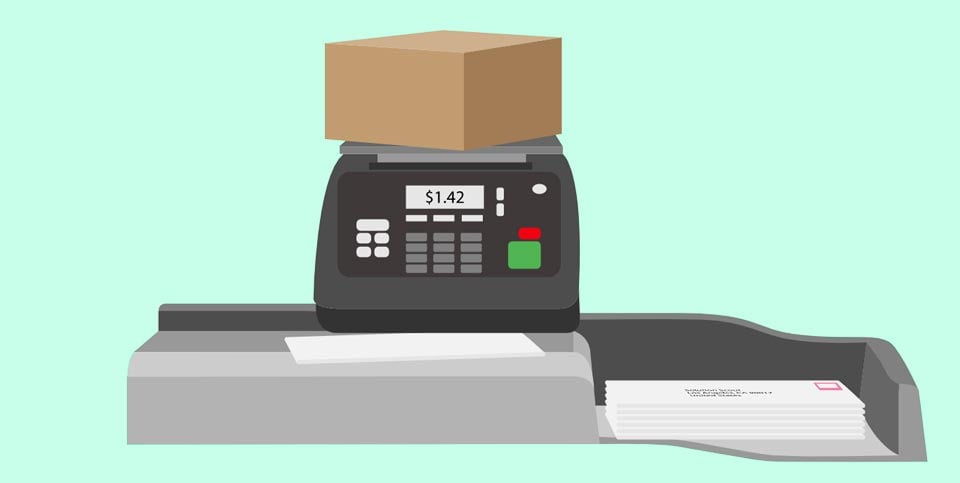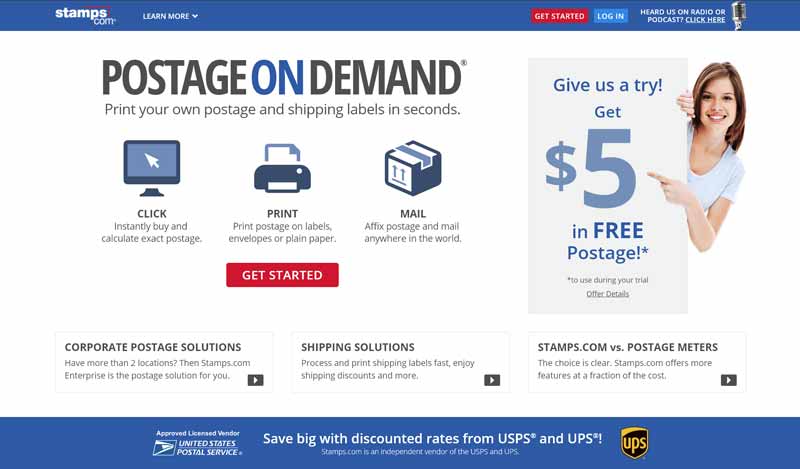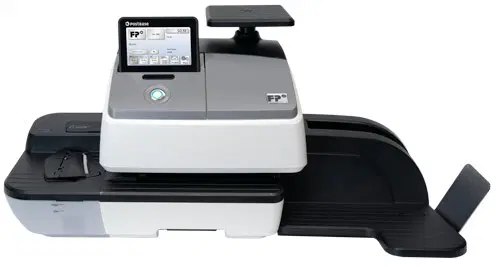Our research shows postage meters could save you up to 24% compared to using stamps. That is quite a lot of savings that your business could use to reward top performers or improve your coffee service.
This ultimate guide covers everything you need to know about postage meters, including what they are, the benefits of having one for your business, and the best postage meters. We’ll also cover the pros and cons for all your alternative options.
What Is a Postage Meter?
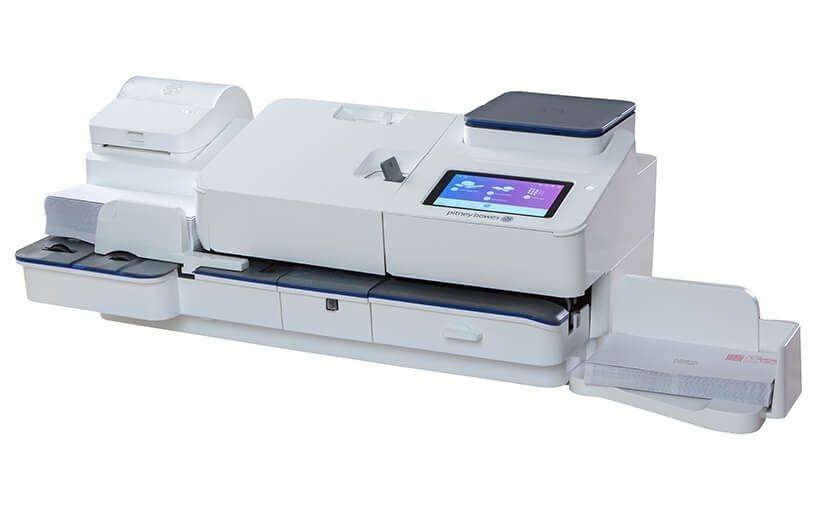
A postage meter is a machine that prints postage directly onto envelopes or labels to apply to your packages.
It will weigh your mail and calculate the exact price of your postage, saving you from over paying on postage.
Aside from savings on postage, postage meters can save you and your team from a considerable amount of time taking trips to the post office (and waiting in line). They also allow you to track your postage spending.
How Do Postage Meters Work?
The scale on the machine allows you to weigh parcels and then choose the correct rate by choosing from the different postal class options.
Once you have selected the rate and class, the machine will print the postage directly onto the package or onto a label to stick on the package for shipping.
Most postage meters include a screen that walks you through each step of the process.
When you lease a postage meter, you prepay funds onto the machine. Each time you send mail or a package, it deducts the correct amount from your balance. As the prepaid funds run out, you can add more via an online account.
Related: Postage Meter Rate Changes
How Much Do Postage Meters Cost to Lease?
To help prevent postal fraud, the USPS does not allow postage meters to be bought. You can rent or lease one from an authorized dealer.
Typically when you rent or lease a postage meter, you will sign a one- or two-year contract. This contract will include a monthly rental fee. The average business will pay between $20 and $50 per month to rent a postage meter, but it could be as much as $200. However, that is solely the price of the machine. The more features you add on, the higher the price goes up.
On top of the rental price, there is a $200 fee per year for the license to use a postage meter. After the rental price and license fee, then comes the actual cost of the postage itself. The postage cost depends on the size and weight of your mail and the class you use.
You will need to invest in ink, printer tape, paper, envelopes, etc. Many providers offer discounts to businesses using their postage meters, so there is potential to save on consumables.
Related: Postage Meter Rental – USPS Postage Meters
Postage Meter Components
Most postage meters use a fairly standard set of components. Those components include:
Meter
Calculates the postage and distributes the funds. Some providers may refer to this as a “frank”.
Feeder
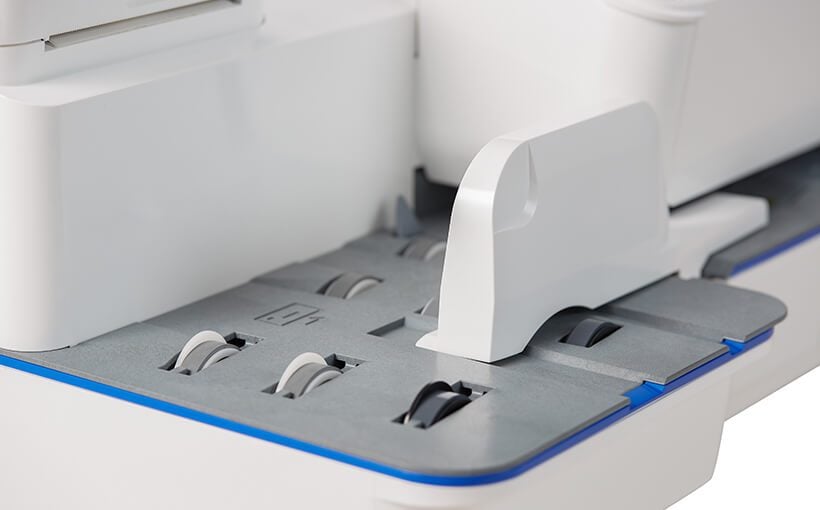
Guides the package or envelope through the meter and printer. Many postage meters are manual or semi-automatic, but fully automatic feeders are available at a higher cost.
Scale
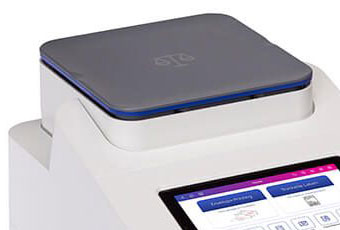
Weighs packages and envelopes to determine the exact postage based on the class you choose.
One crucial difference between models is how much weight their scales can handle. When choosing a postage meter, it is important to choose one that can handle the weight of your heaviest packages.
Some postage systems offer high-speed weighing as part of their automation process, allowing dynamic processing of mixed mail with rates up to 90 letters per minute.
Printing System
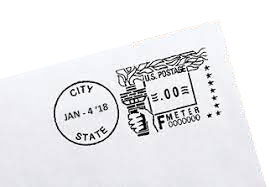
Prints the postage directly onto the envelope or sticky label to be affixed to a package.
Most postage meters either use inkjet or thermal printing. There isn’t much of a difference between the two types of printing, ultimately it comes down to the price of ink refills.
Exit Tray
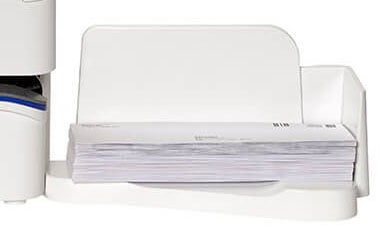
Once mail is weighed, stamped, and sealed, it ends up neatly sorted in the exit tray.
Display Screen
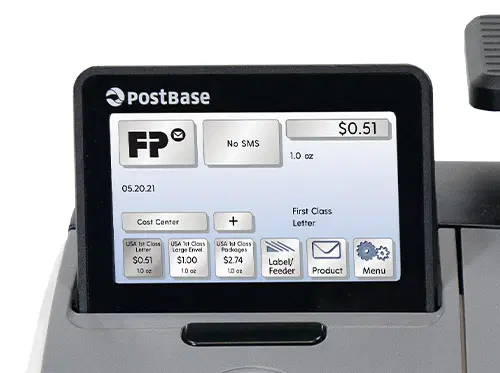
This is where you can select the postal class and date for the postage. It also displays the instructions to walk you through the process and allows you to select the various functions.
Extra Features for Postage Meters
Sealer
Automatically moistens the seal and closes the envelope as it moves through the postage meter. This can be a big time saver.
Note that a sealer requires regular maintenance and cleaning, otherwise they are prone to malfunctioning.
Shortcut and Memory Keys
Shortcut keys make common tasks easier to perform.
Memory keys store tasks such as billing codes for items sent to a particular country or address.
Keyboard
Makes it easier to search for functions and input address information.
Touch Screen
More effective than using buttons to scroll up and down to find functions.
Shape-Based Pricing
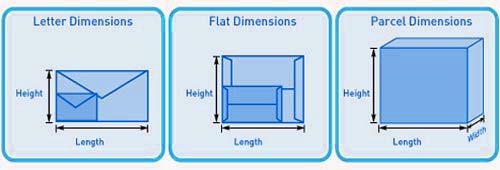
Postage priced on weight alone doesn’t reflect the true USPS processing and delivery costs, especially for awkward shaped items.
Automated equipment using shape-based pricing can reduce costs and ensure accurate postage.
Oversized Exit Trays
Hold large amounts of mail. Some exit trays are small and must be cleared out very often.
If your business has a high volume of mail going through every day, a larger exit tray is a great feature to have.
Conveyor Track
Some large capacity postage meters have a conveyor belt in the exit tray to sort and organize mail. This can be an useful tool for businesses with high-volume mail rooms.
Postage Meter Benefits
Postage meters are an excellent option for businesses to save time and money. If your business sends out a lot of mail, then investing in a postage meter is a smart choice.
Postage meters help your company save time by preventing unnecessary trips to the post office. Also, there’s no waiting in line at the post office.
Applying exact postage is the primary way you’ll save money using a postage meter. You are also eligible to receive discounted postage rates through USPS.
Postage meters reduce the risk of fraudulent charges by eliminating petty cash and checks for postage. Reports can show you which departments are spending the most on postage.
Postage Meter Alternatives
There are companies that do not use a postage meter in their business and instead rely on one of these alternatives.
Stamps
While stamps are an easy alternative, they usually involve trips to the post office. And, unless you’re shipping flat rate, you will apply more postage than necessary on your packages.
Benefits of stamps:
- No equipment necessary
- No contract
Issues with stamps:
- Trips to the post office
- Waiting in line at the post office
- Not eligible for Commercial Base Pricing discounts
- Pay with cash or credit at the post office
- You can only mail during hours the post office is open
Online Postage
Purchasing postage online and printing directly from your computer is a viable alternative to purchasing a postage meter. You can also purchase shipping labels online.
While online postage saves a trip to the post office, unless you have an accurate scale to weigh mail, you will apply more postage than necessary.
Online postage makes the most sense if you are a sporadic mailer.
Benefits of online postage:
- Print postage directly from your computer
- Add a company logo or a message to your envelope
- Easy to keep track of current postal rates
- Track expenses
- Available 24/7
Issues with online postage:
- Manual, multi-step process
- It requires a printer, ink, and labels
- There may be fees for additional users
- You need to keep a credit card on file
Print to Mail Services
This is a service where you send documents and addresses electronically to a vendor. Then the vendor takes care of the printing, folding, sealing, mailing, and tracking of your mail.
Print to mail can be a suitable option if you don’t mind the additional fees that come with outsourcing.
Benefits of print to mail services:
- Efficient bulk mailing capabilities
- Fully automated process
- No equipment necessary
- Expense tracking available
- No trips to the post office
- Available 24/7
Issues with print to mail services:
- Outsourcing fees
- Does not work for shipping packages
For some businesses, a postage meter may not be necessary and you may find an alternative is more suitable. Monitor your expenses and determine if the savings would be worth the effort. Be sure to include the time spent, since it can be a considerable hidden expense.
Types of Postage Meters
The speed and capacity of a postage meter usually determines which type it is.
Small Business Postage Meters
Designed for small businesses that send around 35 pieces of mail per week.
Small business postage meters typically have a processing speed of 20 to 40 PPM (pieces per minute).
The scale on these units can usually only handle up to 10 lbs. They are suitable for a business who sends out enough mail to need a postage meter, but not enough to warrant a high volume meter.
Medium / Commercial Postage Meters
Made for larger businesses that send out a few hundred pieces of mail per week.
Commercial postage meters are at least partially automated. They can handle various sizes and shapes of mail, making it easier for a larger business to handle demand and ship packages.
The processing speed is usually between 100 and 200 PPM. Most models offer custom postage graphics.
The integrated scale usually supports up to 15 lbs., though some can handle up to 100 lbs.
Large / Corporate Postage Meters
These have the most functions and automation. The scale on corporate postage meters can have a capacity up to 150 lbs. Just like the smaller machines, these machines offer custom graphics.
Corporate postage meters typically have a processing speed between 100 and 350 PPM, making them appropriate for large businesses with high volumes of mail going out every day.
Understanding your current and anticipated mail volume will help you choose the right postage meter.
Best Postage Meters
1. Pitney Bowes
Pitney Bowes is the most well-known name in postage meters and mailroom equipment. They received a 9.9 from Side by Side Reviews and are the top company in the game as far as size and revenue.
They are currently serving over 1.5 million customers, including 90% of Fortune 500 companies.
Pitney Bowes Products
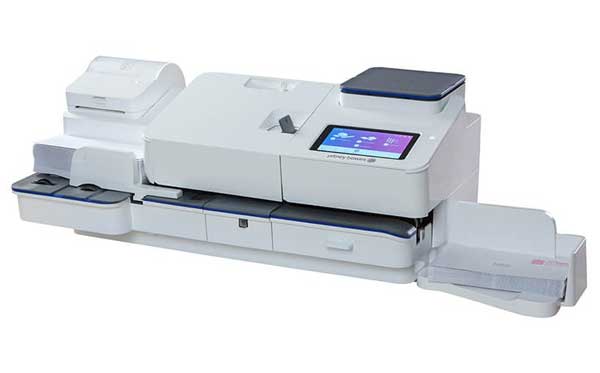
Pitney Bowes Customer Service
Pitney Bowes has an excellent rating and serves so many customers for a reason. Their customer service is exceptional. They are there for their customers to answer any and all questions and take care of any issues.
Their reputation precedes them as one of the best in the industry. They hold true to that reputation in many ways, including how they treat their clients and customers.
2. Quadient
According to Side by Side Reviews, Quadient (formerly Neopost) is number two in postage meter vendors. They received a score of 9.7 overall and offer many products and services.
Quadient Products
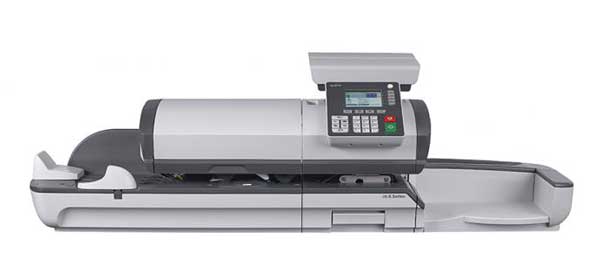
Quadient Customer Service
Quadient offers many customer support systems directly on their website. They are also readily available to answer any questions and have a 96% customer satisfaction rate.
They are easy to contact and readily available, and they offer a number of online resources to help with support and maintenance of all of their products and services.
3. FP Mailing Solutions
With an overall rating of 9.6 on Side by Side Reviews, FP Mailing Solutions is a great option. Offering many products and services, many businesses could benefit from leasing a postage meter from this company.
FP Mailing Solutions Products
FP Mailing Solutions Customer Service
FP Mailing services offers support for all questions related to their products and services. Users can find exactly what they are looking for right on their easy-to-navigate website.
They also offer person to person support for questions that cannot be answered or explained online.
4. Data-Pac
Data-Pac is the newest postage meter provider on our list and was the first to be added to the USPS’ list of authorized providers in more than 25 years.
They work with businesses of all sizes and produce excellent high-volume processing equipment.
Data-Pac Products
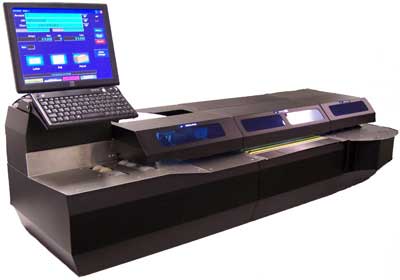
This high-volume digital mailing system allows the operator to process letters and flat packages at a rate of up to 100 PPM. It comes with a 70 pound scale and extras such as a 15″ touch-screen PC, custom form printing, E-Certified form of printing, and a full international mail manual.
Data-Pac Customer Service
Data-Pac works with small- and medium-sized businesses and allows them to quickly and effectively process mail. They offer a commercial discount rate of up to 11% and the machine itself is easy to use.
They are a newer company, but are quickly building their reputation.
Questions to Ask a Vendor
How long is a typical postage meter lease?
Typically, you can get a discount on your monthly payments if you opt for a longer lease. This is an important question to ask before signing anything.
If your mail volume is high, then you could probably benefit from upgrading your services and products every once in a while. While some leases will allow you to upgrade your lease, this is something that you should discuss ahead of time.
When does my lease end?
Be sure to find out the exact start and end date of your lease to avoid any confusion and/or extra fees.
While most of the time start and end dates are clear, if a lease automatically renews, you want to make sure you know exactly when the end date is.
How can we purchase postage?
Loading postage to your meter can vary depending on your vendor. Some vendors offer an online payment option, while others allow you to add more postage directly from the postage meter by direct debit, ACH, or via your account with USPS.
There are some vendors who offer a mail now, pay later option. Be sure to discuss this ahead of time with your vendor so you know how to reload postage when it runs out.
How do I track my spending and postal activity?
Be sure to talk to your rep about data analysis options and what they offer, including how to access your data.
The data includes:
- Your account
- Model
- Serial numbers
- Complete inventory of leased products
- Payment information
- Maintenance history
- Meter usage
- Supplies
You should also be able to view your postage activity, track the dates on which you loaded postage, the amount loaded, and all usage by date and user.
Is technical support included in the lease?
Technical support can vary, so it is important to know what type you will get with your lease, if any. Some vendors offer phone support, while others provide on-site support.
Most contracts don’t include tech support for basic things such as reloading postage or checking your balance.
Know what your provider offers before entering into a contract with them.
What am I paying for?
Make sure you are aware of everything included in your lease agreement before signing. Have your rep give you a breakdown of each line item so you know exactly what you are paying for.
Does your rep offer reduced pricing or discounts?
Many vendors offer great discounts that you won’t know about, unless you ask. Be sure to find out about additional savings like:
- Price breaks for including multiple locations on your account
- Comparing prices to keep your current equipment versus upgrading to newer equipment
- Price-matching with other vendors
- Promotional pricing on certain models
- Reconditioned, re-manufactured, or demo versions
- Special programs for new customers
Some vendors also offer month-end or quarterly deals. If you are renewing a lease, be sure to ask about the remaining balance on your current contract, making sure not to lose that balance.
Postage Meters for Alternative Carriers
Most postage meters will also work with alternative carriers such as FedEx and UPS.
You should always double check with your vendor at the time of the lease signing to ensure that they provide these services, but most of them work just fine with these carriers, and the USPS.
Allowable Types of Mail
Note: The only class of mail that cannot be processed with a postage meter is periodical, such as magazines.
Postage meters can be used for postage on first class, priority, presorted first class, express, and international mail, as well as all packages.
Bulk Mail
The rules are a bit different when you use a postage meter to stamp bulk mail. The meter is only able to add an estimated amount of postage to each item of bulk mail and the additional postage should be paid directly to the post office.
To send bulk mail you need to apply for a permit using a Mailing Permit Application and Customer Profile form.
Certified Mail
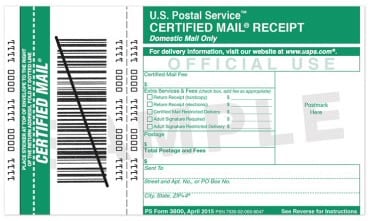
You can apply postage to certified mail using a postage meter. When sending certified mail you always need to apply the standard green and white label and pay the additional fee.
The menu on your postage meter should walk you through the steps and help you choose the appropriate tracking option.
Can Your Business Benefit From Using a Postage Meter?
If you are a smaller company and don’t rely too heavily on sending mail or shipping packages, then you may not need to invest in a postage meter.
However, if your company sends out a lot of mail and is looking for ways to cut costs and save time and effort, then a postage meter may be exactly what you need.
A postage meter is an excellent way to keep postage costs to a minimum, process all business mail efficiently, track your company’s spending by department, and aid in streamlining your mail system.
When a small business invests in a postage meter, they are changing the way their mail system works – for the better.
